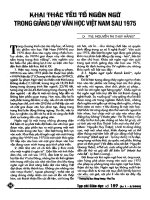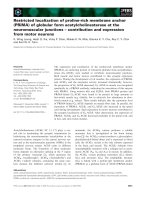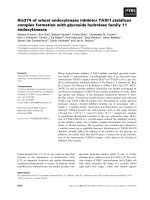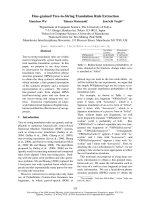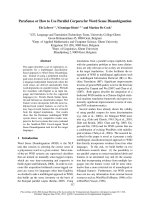báo cáo khoa học: "Restricted Maximum Likelihood to estimate variance components for mixed models with two random factors Karin MEYER" ppt
Bạn đang xem bản rút gọn của tài liệu. Xem và tải ngay bản đầy đủ của tài liệu tại đây (603.89 KB, 19 trang )
Restricted
Maximum
Likelihood
to
estimate
variance
components
for
mixed
models
with
two
random
factors
Karin MEYER
lnstitute
of
Animal
Genetics,
University
of
Edinburgh
West
Mains
Road,
Edinburgh
EH9
3JN,
Scotland
U. K.
and
Genetic
Improvement
of
Livestock,
Department
of
Animal
and
Poultry
Science,
University
of
Guelph, Guelph,
Ontario
N1G
2W],
Canada
Summary
A
Restricted
Maximum
Likelihood
procedure
is
described
to
estimate
variance
components
for
a
univariate
mixed
model
with
two
random
factors.
An
EM-type
algorithm
is
presented
with
a
reparameterisation
to
speed
up
the
rate
of
convergence.
Computing
strategies
are
outlined
for
models
common
to
the
analysis
of
animal
breeding
data,
allowing
for
both
a
nested
and
a
cross-
classified
design
of
the
2
random
factors.
Two
special
cases
are
considered :
firstly,
the
total
number
of
levels
of
fixed
effects
is
small
compared
to
the
number
of
levels
of
both
random
factors ;
secondly,
one
fixed
effect
with
a
large
number
of
levels
is
to
be
fitted
in
addition
to
other
fixed
effects
with
few
levels.
A
small
numerical
example
is
given
to
illustrate
details.
Key
words :
Restricted
Maximum
Likelihood,
variance
component
estimation,
nested
design,
full
sib
family
structure.
Résumé
Estimation
des
composantes
de
la
variance
par
le
Maximum
de
Vraisemblance
Restreint
dans
un
modèle
mixte
à
deux
facteurs
aléatoires
Une
méthode
d’estimation
des
composantes
de
la
variance
par
le
Maximum
de
Vraisemblance
Restreint
est
décrite
dans
le
cas
d’un
modèle
mixte
à
une
seule
variable
avec
2
facteurs
aléatoires.
Un
algorithme
de
calcul
du
type
E.M.
est
présenté
avec
une
reparamétrisation
pour
accélérer
la
vitesse
de
convergence.
Des
stratégies
de
calcul
sont
abordées
pour
les
modèles
d’analyse
génétique
les
plus
courants
avec
2
facteurs
aléatoires
hiérarchiques
ou
croisés.
Deux
cas
particu-
liers
sont
décrits :
premièrement,
le
nombre
total
de
niveaux
des
effets
fixés
est
faible
comparati-
vement
à
celui
des
facteurs
aléatoires ;
deuxièmement,
un
effet
fixé
avec
un
grand
nombre
de
niveaux
est
ajouté
aux
précédents.
Un
petit
exemple
numérique
illustre
les
détails.
Mots
clés :
Maximum de
Vraisemblance
Restreint,
estimation
des
composantes
de
la
variance,
modèle
hiérarchique,
famille.s
de
pleins
frères.
I.
Introduction
Recently
Maximum
Likelihood
(ML)
and
related
procedures
to
estimate
variance
components
for
unbalanced
data
have
become
popular.
Restricted
Maximum
Likelihood
(REML),
developed
by
P
ATTERSON
&
T
HOMPSON
(1971),
which
in
contrast
to
ML
accounts
for
the
loss
in
degrees
of
freedom
due
to
fitting
fixed
effects,
has
become
accepted
as
the
preferred
method
to
estimate
variance
components
for
animal
breeding
data.
H
ENDERSON
(1973)
described
an
EM-type
ML
algorithm
for
several
uncorrelated
random
effects,
based
on
the
Mixed
Model
Equations
(MME)
for
Best
Linear
Unbia-
sed
Prediction
(BLUP).
Its
REML
analogue
(e.g.
H
ARVILLE
,
1977 ;
HE
rr
DERSON
,
1984)
is
widely
used
although
it
is
slower
to
converge
than
an
algorithm
using
Fisher’s
Method
of
Scoring
(T
HOMPSON
,
1982).
However,
it
is
guaranteed
to
yield
non-negative
estimates
(H
ARVILLE
,
1977).
T
HOMPSON
(1976)
outlined
an
ML
procedure
to
estimate
direct
and
maternal
variances.
Using
small
examples
H
ENDERSON
(1984)
illustrated
REML
algorithms
for
a
variety
of
more
complex
cases,
including
models
accommoda-
ting
additive
and
dominance,
direct
and
maternal
effects
and
a
three-way
classification
where
variance
component
estimates
for
one
random
factor
and
all
random
interactions
were
required.
His
algorithm permits
a
general
form
of
the
matrix
of
residual
errors.
In
a
different
context,
LAIRD
&
WARE
(1982)
discussed
ML
and
REML
estimation
for
longitudinal
data,
invoking
a
two-stage
model
which
accommodated
both
growth
and
repeated
measurement
models.
In
spite
of
well
documented
theory,
most
applications
of
REML
in
animal
breeding
have
been
restricted
to
models
which
include
only
a
single
random
factor
apart
from
the
random
residual
error.
This
paper
describes
a
univariate
REML
procedure
for
models
where
three
variance
components
are
to
be
estimated.
This
encompasses
cases
with
2
uncorrelated
random
effects
and
situations
where
the
variance
components
for
one
random
factor
and
its
random
interaction
with
a
fixed
effect
are
of
interest.
With
an
appropriate
coding
for
the
interaction,
the
latter
is
a
special
cae
of
the
2
random
factor
model.
For
animal
breeding
data,
these
are
commonly
sires
and
dams.
Fre-
quently,
there
are
considerably
more
dams
than
sires,
in
particular
with
artificial
insemination,
and
sires
are
used
across a
wider
range
of
fixed
effects
than
dams.
The
algorithm
has
been
developed
with
such
a
data
structure
in
mind
and
will
be
presented
in
terms
pertaining
to
the
animal
breeding
situation.
II.
The
model
Let
y,
of
length
N,
denote
the
data
vector
and
b,
of
length
NF,
denote
the
vector
of
fixed
effects
including
any
regression
coefficients
for
covanables
to
be
fitted.
Similarly
let
s,
of
length
NS,
and
d,
of
length
ND,
stand
for
the
vectors
of
the
first
(e.g.
sires)
and
second
(e.g.
dams)
random
effect
and
e,
of
length
N,
stand
for
the
random
vector
of
residuals.
X,
Z
and
W are
the
corresponding
design
matrices
for
b,
s
and
d
of
order
N
x
NF,
N
x
NS
and
N
x
ND,
respectively.
The
model
of
analysis
can
then
be
written
as :
with
E(y)
=
Xb,
E(s)
=
0,
E(d)
=
0
and
E(e)
=
0
and
variances
and
covariances
V(s)
=
G!s,
V(d)
=
GD,
V(e)
=
R,
Cov(s,d’)
=
0,
Cov(s,e’)
=
0
and
Cov(d,e’)
=
0
Then
V(y)
=
V
=
Zfi
s
Z’
+
WGpW’
+
R.
Assuming
errors
to
be
uncorrelated
and
variances
to
be
homogeneous
for
each
random
factor,
this
simplifies
to :
where or,
=
V(s
j
),
a’ D =
V(d
k)
and
aw
=
V(em)
for j
=
1,
,
NS,
k
=
1,
,
ND
and
m
=
1,
,
N.
As
and
AD
describe
the
covariance
structure
among
the
levels of
each
of
the
2
random
effects.
In
animal
breeding
terms,
assuming
an
additive
genetic
model,
for
sires
and
dams,
these
are
the
numerator
relationship
matrices.
The
MME
for
(1)
are
then
(H
ENDERSON
,
1973) :
with
variance
ratios
ks
=
(y!1 (y!
and
ÀD
=
u2wlag
(assumed
to
be
the
known
parameter
values).
III.
REML
algorithm
To
account
for
the
loss
in
degrees
of
freedom
due
to
fitting
of
fixed
effects,
REML,
in
contrast
to
ML,
maximizes
only
the
part
of
the
likelihood
of
the
data
vector
y
which
is
independent
of
the
fixed
effects.
This
is
achieved
by
operating
on
a
vector
of
so-called
«
error
contrasts
»,
Sy,
with
SX
=
0
and
hence
E(Sy)
=
0.
A
suitable
matrix
S
arises
when
absorbing
the
fixed
into
the
random
effects
in
(3)
(T
HOMPSON
,
1973).
Differentiating
the
log
likelihood
of
Sy
with
respect
to
the
variance
components
to
be
estimated
then
gives
the
general
REML
equations :
where
Oi
stands
in
turn
for
or,’,
a1
and
u2w.
P
is
a
projection
matrix :
From
(2),
the
derivatives
of
V
required
are :
6v/6u]
=
ZA
s
Z’,
õv/õab
=
WApW’
and
8v/8(T’
= IN
This
gives
the
following
estimating
equations :
where !=y-Xfi-Z&-Wa=S(y-Zfi-Wa)
and
NDFW=N-NS-ND-rank(X)
denotes
the
degrees
of
freedom
for
residual.
Equivalent
expressions
to
(9)
to
(11)
have
been
given
by
H
ARVILLE
(1977),
S
EARLE
(1979)
and
H
ENDERSON
(1984).
Estimates
are
usually
obtained
employing
an
iterative
solution
scheme.
Above
and
in
the
following,
(J&dquo;!,
and
Xi
(or
a;)
are
then
thought
of
as
starting
values
while
a
superscript
« A
»
denotes
estimates
for
the
current
round
of
iteration.
These
equations,
(9)
to
(11),
utilize
only
first
derivatives
of
the
likelihood
function,
resulting
in
an
EM
algorithm
(D
EMPSTER
et
C
1L.,
1977).
Alternatively,
the
right
hand
side
of
(6)
can
be
expanded
to
include
second
derivatives,
resulting
in
an
algorithm
equivalent
to
Fisher’s
Method
of
Scoring.
Details
are
given
in
the
Appendix
(A).
While
the
EM
algorithm
requires
only
the
diagonal
blocks
(Css
and
Cp
o)
of
the
inverse
of
the
coefficient
matrix
for
random
effects
and
traces
of
their
simple
products
with
the
corresponding
inverse
of
the
numerator
relationship
matrix,
off-diagonal
blocks
and
more
complicated
traces
are
required
for
the
Method of Scoring
algorithm
(see
(A3)
in
relation
to
(9)
to
(11)).
Hence
computational
requirements
per
round
of
iteration
for
the
latter
are
considerably
higher.
Though
the
EM
algorithm
can
be
slow
to
converge,
in
particular
for
ratios
of
variance
components
common
to
animal
breeding
data
(T
HOMPSON
,
1982)
it
is
often
preferred
for
its
computational
ease
and
the
fact
that
it
guarantees
estimates
in
the
parameter
space.
IV.
Reparameterisation
T
HOMPSON
&
M
EYER
(1986)
described
a
reparameterisation
to
speed
up
convergence
of
a
REML
algorithm
based
on
first
derivatives
of
the
likelihood
function.
It
was
derived
considering
the
expectations
of
mean
squares,
resulting
from
the
orthogonal
partitioning
of
sums
of
squares
due
to
factors
in
the
model,
in
a
balanced
design.
For
a
model
with
one
random
factor,
for
instance,
where
the
variance
components
within
(Q
w)
and
between
(
U2
)
random
groups
are
of
interest,
it
was
suggested
to
estimate
parameters
aW
=
(T’
and
aB
=
U2
+
<TVK.
The
latter
is
the
variance
of
a
group
mean
if
K
is
the
group
size.
For
K -
00
, a
B
reduces
to
of,.
For
a
balanced
design
with
K
equal
to
the
group
size,
estimates
of
ae
and
a!
were
obtained
in
one
round
of
iteration.
For
the
unbalanced
case
a
value
of
K
equal
to
the
average
group
size
increased
speed
of
convergence
markedly
over
the
EM
algorithm
on
the
original
scale
(K
=
00),
especially
if
Qa
was
small
compared
to
ot
2
A.
Nested
design
For
a
model
with 2
random
factors
it
is
necessary
to
distinguish
between
a
nested
and
a
cross-classified
design.
If
the
second
random
factor,
for
instance
dams
(d),
is
nested
within
the
first,
for
instance
sires
(s),
expectations
of
mean
squares
in
a
balanced
hierarchical
analysis
of
variance
suggest
a
reparameterisation
to
aW
=
Qw,
ap
=
<
T6
+
(
T2
w
/K
,
and
as
=
as
+
ap
lKs
=
Q
’-s
+
<T61K
s
+
0!/K.sK!,.
THOMPSON
&
M
EYER
(1986)
demonstrated
for
Kp
equal
to
the
average
dam
group
size
and
K,
equal
to
the
average
number
of
dams
per
sire
a
considerable
reduction
in
rounds
of
iteration
required
for
convergence,
as
compared
to
values
of
KS
=
Kp
=
oc.
Again,
in
the
balanced
case
estimates
were
obtained
in
one
round.
Differentiating
the
log
likelihood
of
Sy
with
respect
to
the
new
parameters
aS,
aD
and
aW
and
equating
the
resulting
expressions
to
zero,
«
improved
»
estimates
for
the
three
variance
components
can
be
derived.
The
first
variance
component,
or2s,
is
derived
as
before,
i.e.
according
to
(9),
while
(10)
is
replaced
by :
The
residual
variance
is
then
found
as :
Clearly,
(12)
and
(13)
reduce
to
(10)
and
(11)
respectively,
if
Ks
and
KD
are
00.
Alternatively,
an
estimator
of
the
general
form :
can
be
used
to
determine
Oi
=
as,
aD
and
aw,
where
BL/O
i
denotes
the
partial
derivative
of
the
log
likelihood
of
Sy
with
respect
to
6,.
M
stands
for
the
number
of
levels
or
degrees
of
freedom
pertaining
to
the
respective
random
factor
(see
T
HOMPSON
&
M
EYER
(1986)
for
a
reasoning
for
the
latter).
Estimates
of
the
variance
components
are
then
found
as
81
=
&
w,
8)
=
aD
-
aw
/k
D
and
â-!
=
&
s
-
aD
/Ks.
This
implies
that,
in
contrast
to
the
scheme
above
(i.e.
(12)
and
(13)),
estimates
of
ar’
w
and or2D
rather
than
the
starting
values
are
used
in
back
transforming
from
the
reparameterised
to
the
original scale.
This
appears
to
be
advantageous.
For
Oi
=
as,
aD
and
aw
in
turn,
this
gives
(from
14) :
/
Obviously,
with
aW
=
u!
rearranging
(17)
yields
(13).
B.
Crossclassified
design
Repitrameterised variables
for
the
crossclassified
design
are
Œ
W
(T
,
2
Œ
D
=
(T
+
u!1
KD
and
as
=
as
+
CF
2
w /K
s
where
suitable
values
for
KD
and
Ks
may
be
the
average
number
of
records
per
dam
and
sire,
respectively.
From
(14),
/
for
Oi
=
aD
and
aW,
respectively,
and
(15)
for
Oi
=
as.
Estimates
of
crw
and
ap
are
then
determined
as
for
the
nested
design
and
as
=
as -
aw
/Ks.
V.
Computing
strategy
The
REML
algorithm
as
described
so
far
centres
around
the
matrix
S
which
is
of
order
equal
to
the
number
of
observations.
For
most
applications,
S
cannot
be
calculated
directly
but
often
special
features
of
the
data
structure
can
be
exploited
to
obtain
the
required
terms
indirectly.
A.
Few
fixed
effects
Consider
a
model
where
the
total
number
of
levels
of
fixed
effects,
including
any
regression
coefficients
for
covariables,
is
small
compared
to
the
number
of
levels
of
the
first
random
effects.
Assume
further
that :
i)
there
are
more
levels
for
the
second
than
for
the
first
random
effect
ii)
AD !
I
ND
iii)
As =
I
NS
The
steps
are
then :
1)
Absorb
d
into
s and
b.
This
gives
MME
with
K
=
IN -
W(W’W
+
BoAD
’)
’
’W
If
AD
=
’
NII
(W’W
+
apAp’)
is
diagonal
and
d
can
be
absorbed
one
level
at
a
time.
2)
Absorb
s
into
b
giving
If
d
is
nested
within
s,
Z’KZ
is
diagonal
and,
for
As =
I
NS
,
(Z’KZ
+
ks
as’)
is
easily
inverted.
3)
Obtain
solutions
for
the
fixed
effects
as :
and
backsolutions
for
the
random
effects
4)
The
REML
algorithm
requires
traces
involving
the
diagonal
blocks,
C
ss
and
Cpp,
of
the
inverse
of
the
coefficient
matrix.
These
can
be
derived
using
partitioned
matrix
results,
utilising
inverses
and
matrix
products
arising
during
the
absorption
steps.
The
traces
are
then :
Hence,
3 additional
symmetric
matrices
have
to
be determined
to
calculate
the
required
traces
indirectly :
LS
pAp’L’
Sp
of
order
equal
to
the
number
of
levels
of
s,
and
1-xsAs !L!xs
and
T,
both
of
order
equal
to
the
total
number
of
levels
of
fixed
effects
including
any
regression
coefficients.
These
can
efficiently
be
calculated
when
absorbing
the
random
effects.
The
quadratics
in
the
vector
of
random
effects,
s’ A
sls
and
d’Ap’d,
can
be
calculated
directly.
The
corresponding
term
for
residuals
is
then
determined
as :
B.
One
fixed
effect
with
many
levels
Often
the
model
of
analysis
includes
one
fixed
effect
with
many
levels,
too
many
to
pursue
the
approach
described
above.
Usually,
however,
there
are
still
considerably
more
levels
of d
so
that
it
appears
appropriate,
first
to
absorb
d
and
then
to
absorb
the
major
fixed
effect
into
s
and
any
additional
fixed
effects
or
covariables
to
be
fitted.
This
strategy
requires
that
the
levels
of
d
are
nested
within
the
levels
of
the
major
effect
or
at
least
within
a
sufficiently
small
group
thereof.
Only
then
can
the
inverse
required
to
absorb
the
fixed
effect
be
calculated.
A
typical
example
is
the
analysis
of
dairy
data
where
a
large
number
of
herd-year-season
(HYS)
effects
has
to
be
taken
into
account.
Assuming
cows
do
not
change
herds,
repeated
records
for
a
cow,
for
instance
for
milking
speed
or
calving
ease,
are
nested
within
herds.
Details
for
this
case
are
outlined
in
the
Appendix
(B).
VI.
Numerical
example
Consider
records
on
progeny
of
5
sires
and
30
dams,
subject
to
3
treatments
in
2
time
periods,
as
summarized
in
table
1.
Dams
are
nested
within
sires
and
within
time
periods.
Let
the
model
of
analysis
include
the
6
time
x
treatment
subclasses
(h
h)
and
two
sexes
(b
;)
as
fixed
effects,
litter
size
(X
h;jkl)
as
linear
covariable
and
sires
(
Sj
)
and
dams
(d
j
as
random
factors,
where
b,
denotes
the
regression
on
litter
size
and
e
h;;
&dquo;
the
residual
error
associated
with
Y
hijkl
,
the
record
for
the
1-th
progeny
of
dam
k
and
sire j
and
sex
i
in
treatment
x
time
class
h.
Assume
both
sires
and
dams
are
unrelated,
i.e.
As
=
I
NS
and
Ap
=
I
No
A. Absorption
strategy
for
few
fixed
effects
For cfl
=
10,
Qo
=
12
and
(
T2
=
120,
submatrices
for
time
x
treatment
classes
in
period
I
are :
Absorbing
all
dams,
With
dams
nested
within
sires,
the
coefficient
matrix
for
sires
absorbing
dams
is
diagonal.
Z’KZ
=
Diag.
{24.954
25.875
28.599
29.119
33.865},
(Z’Ky)’ _ (2 786.4
2 762.2
3 017.0
3 246.8
3 745.0)
and
LS
pAp’L
S
p’
=
Diag.
{1.3186
1.3776
1.4239
1.2901
1.6867}
The
first
term
required
to
calculate
tr(Cpp)
is
tr(Ap’Hp)
=
1.57588.
Absorbing
sires,
(sub)matrices
corresponding
to
X!’KX!
are :
The
first
term
in
(27)
is
then
tr(A
s
’H
s)
=
0.1752778,
and
the
second
term
in
(28)
is
tr(HsL!.A.’Ls.’)
=
0.1242176.
With
more
than
one
fixed
effect
fitted,
the
coefficient
matrix
is
not
of
full
rank.
Hence
the
row
and
column
of
X’MX
pertaining
to
the
first
level
of
each
additional,
i.e.
other
than
the
first,
fixed
effect
are
set
to
zero.
Obtaining
a
generalized
inverse
gives
tr(H
FL
xsAs
IL
xs
’) =
0.0634841,
tr(H
r
T)
=
0.1160263,
tr(A
S
’C
s
,)
=
0.1877017
and
tr(A
D
’C,,) =
1.867190.
Corresponding
results
pursuing
a
computing
strategy
suitable
for
a
model
with
one
fixed
effect
with
many
levels
are
given
in
the
Appendix
(C).
B.
Solutions
For
both
computing
strategies,
solutions
(or
backsolutions)
for
the
fixed
effects
are
h = [112.672
112.862
111.485
110.480 111.532
111.116]
and
bA
’ _
[0
11.349 -
0.71834],
while
sire
and
dam
effects
are
predicted
as
s’
=
[2.4608 -
1.3884 -
2.8995
1.4868
0.3403]
and
d
= [0.1614 0.6646 0.930
0.1335
3.5630].
This
gives
products
of
solutions
and
right
hand
sides
bA
’X
Ay
= - 85,022.4,
h’By
=
3,576,705.2,
s’Zy
=
285.5
and
d’Wy
= 2 636.4.
With
a
total
sum
of
squares
(SS)
of
3,526,153,
the
residual
SS
is
31,548.2.
The
quadratics
required
in
the
estimation
equations
are
then
&dquo;s’As’&dquo;s
=
18.716404,
d’A
õld
=
119.472337
and
e’e
=
30
,
128
.9.
The
EM
algorithm
on
the
original
scale
gives
estimates
u)
=
8.2481
(first
line
of
(9))
or
u2
=
6.8120
(second
line
of
(9)),
Qp
=
11.4512
(first
line
of
(10))
or
(T2
=
10.5465
(second
line
of
(10))
and
Qw
=
110.7988
(eq.
(11)).
The
average
number
of
progeny
per
dam
is
k,, =
294/30
=
9.8
and
the
average
number
of
dams
per
sire
k,
=
30/5
=
6.0.
This
gives
aD
= 24.2449
and
as
=
14.0408.
Using
estimators
of
form
(14)
then
gives
as
=
9.72366,
aD
=
21.89974
and
aW
=
81
=
110.70115
(from
(15),
(16)
and
(17))
with
estimates
of
the
original
components
of
8§
=
10.6037
and
8)
= 6.0737.
Estimates
for
subsequent
rounds
of
iteration
are
given
in
table
2
for
both
the
reparameterisation
(using
(15),
(16)
and
(17))
and
the
« better
version
of
the
EM
algorithm
on
the
original
scale
(using
(11)
and
the
second
lines
of
(9)
and
(10)).
Received
November
12,
1985.
Accepted
September
5,
1986.
Financial
support
has
been
provided
by
the
Agricultural
and
Food
Research
Council
(A.F.R.C.),
U.K.,
and
the
Canadian
Association
of
Animal
Breeders.
I
am
grateful
to
R.
THOMPSO
N
for
helpful
comments
and
L.R.
ScttneFFee
for
comments
on
the
manuscript.
References
D
EMPSTER
A.P.,
LAIRD
N.M.,
R
UBIN
D.B.,
1977.
Maximum
likelihood
from
incomplete
data
via
the
EM
algorithm.
J.
Roy.
Stat.
Soc.,
Series
B,
39,
1-22.
HnRVtLLE
D.A.,
1977.
Maximum
likelihood
approaches
to
variance
component
estimation
and
to
related
problems.
J.
Am.
Stat.
Assoc. ,
72,
320-340.
H
ENDERSON
C.R.,
1973.
Sire
evaluation
and
genetic
trends.
Proc.
Anim.
Breed.
Genet.
Symp.
in
Honor
of Dr
J.L.
Lush,
Blacksburg,
Virginia,
July
29,
1972.
10-41,
ASAS,
Champaign,
IL.
H
ENDERSON
C.R.,
1984.
Applications
of
Linear
Models
in
Animal
Breeding.
462
pp.,
University
of
Guelph,
Guelph,
Ontario.
LAIRD
N.M.,
WARE
J.H.,
1982.
Random-effects
models
for
longitudinal
data.
Biometrics,
38,
963-
974.
PA
TT
ERSON
H.D.,
T
HOMPSON
R.,
1971.
Recovery
of
interblock
information
when
block
sizes
are
unequal.
Biometrika,
58,
545-554.
S
EARLE
S.R.,
1966.
Matrix
Algebra
for
the
Biological
Sciences.
296
pp.,
Wiley,
New
York.
S
EARLE
S.R.,
1979.
Notes
on
variance
component
estimation :
A
detailed
account
of
maximum
likelihood
and
kindred
methodology.
Paper
BU-673
M,
Biometrics
Unit,
Cornell
University,
Ithaca,
N.Y.
T
HOMPSON
R.,
1973.
The
estimation
of variance
and
covariance
components
with
an
application
when
records
are
subject
to
culling.
Biometrics,
22,
527-550.
T
HOMPSON
R.,
1976.
The
estimation
of
maternal
genetic
variances.
Biometrics,
32,
903-917.
T
HOMPSON
R.,
1982.
Methods
of
estimation
of
genetic
parameters.
Proc.
Second
Int.
Congr.
Genet.
Applied
Livest.
Prod.,
Madrid,
Spain,
vol.
V,
95-103,
Edit.
Garsi,
Madrid.
T
HOMPSON
R.,
M
EYER
K.,
1986.
Estimation
of
variance
components :
What
is
missing
in
the
EM
algorithm ?
J.
Stat.
Comput.
Simulation
(in
press).
Appendix
A.
Method
of
scoring
Utilizing
that
PVP
=
P
and
that
V
is
linear
in
the
parameters
to
be
estimated
(see
(2)),
(6)
can
be
rewritten
as :
This
yields
a
system
of
linear
equations
to
be
solved
simultaneously :
with
0
=
10il
the
vector
of
parameters
to
be
estimated,
q
=
{q;} =
{y’PõV 1õ6¡Py}
a
vector
of
quadratics
and
B
=
{b;j
}
=
(tr(P6V/60
i
P6V/60
j)
a
symmetric
matrix
of
coefficients.
Apart
from
a
factor
of
1/2,
B
is
equal
to
the
information
matrix
for
0.
The
elements
of
B
for
the
model
considered
here
are :
The
quadratics
required
are
equel
to
those
in
the
EM
algorithm :
B.
Computing
strategy
for
a
model
including
a
fixed
effect
with
many
levels
Partition
the
vector
of
fixed
effects
and
the
design
matrix
in
(1),
according
to
the
«
major
» fixed
effect
h
with
many
levels
and
any
additional
fixed
effects
and
covaria-
bles.
!
I
r
-,
Let
the
subscript
h
denote
the
submatrix
or
vector
for
the
hth
group
of
levels
of
h.
The
MME
absorbing
d,
(20),
can
then
be
rewritten
as :
NH
with
B’KB
=
2!
B’,K,B,,
where
&dquo; I+
&dquo;
denotes
the
direct
matrix
sum
(S
EAR
LE,
1966)
and
h=l
NH
the
number
of
groups
of
the
major
fixed
effect.
This
holds
only
if
Ap
has
a
corresponding
block
structure,
i.e.
if
all
covariances
between
levels
of
d
in
different
groups
are
zero.
Absorbing
h
then
gives
the
MME
for
sires
and
additional
fixed
effects
as :
with
N
=
K -
KB(B’KB)-B’K.
From
(AS)
it
follows
that
N
is
block
diagonal,
i.e.
N
=
2,
Nh
with :
h!1
Absorbing
any
additional
fixed
effects
then
leaves :
with
F
=
N -
NX
A
(X
A
’NX
At
XA
’N.
Hence
a
direct
inverse
of
order
NS,
equal
to
the
number
of
levels
of
s,
is
required,
to
obtain
solutions :
After
backsolving
for
any
additional
fixed
effects
or
covariables,
backsolutions
for
h and
d
can
be
obtained
group
by
group.
The
quadratic
forms
and
traces
for
REML
are
the
same
as
before
except :
C.
Numerical
example :
absorbing
a
fixed
effect
with
many
levels
Absorbing
treatments
for
one
time
period
after
the
other,
intermediate
results
are
as
follows.
Processing
data
for
period
I
gives :
and
tr(H
BLB
pAp’L
B
p’)
=
0.0497559.
After
absorbing
all
dams
and
treatments,
tr(H
BLB
pAp’L
B
p’)
=
0.1089976,
Again,
setting
the
first
level
of
each
additional
effect
to
zero
and
obtaining
a
generalized
inverse,
yields
tr(H
XT
XX
)
=
0.0469752.
Absorbing
the
additional
fixed
effects
and
covariables
into
sires,
and
the
fourth
term
Of
(A14)
is
tr(CS$T) =
0,!3!3313.

